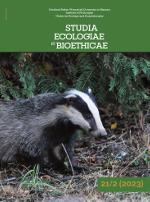Critical Optical Depth Hypothesis for Phytoplankton Growth and Bloom. A New Graphical Approach to the Classic Sverdrup Critical Depth Model
Critical Optical Depth Hypothesis for Phytoplankton Growth and Bloom. A New Graphical Approach to the Classic Sverdrup Critical Depth Model
Author(s): Wojciech SzeligiewiczSubject(s): Energy and Environmental Studies, Environmental Geography, Human Ecology
Published by: Wydawnictwo Naukowe Uniwersytetu Kardynała Stefana Wyszyńskiego w Warszawie
Keywords: critical depth;critical light;Sverdrup model;phytoplankton;growth;competition;optical depth;optical critical depth
Summary/Abstract: A modification to the classic Sverdrup Critical Depth Model relating phytoplankton light-limited net growth in a mixed water column to its depth is presented by introducing optical depth in place of the physical depth of the column, as well as by the inclusion of self-shading and competition among phytoplankton species for light. The concept of critical optical depth of a well-mixed column is used to establish criteria for phytoplankton growth and competitive exclusion. This model shows not only the direction of the growth for a given column, such as the classic Sverdrup model, but also the magnitude of that growth. The model relies on plots of the average specific (per unit biomass) rate of this growth in the column against the optical depth of that column. These graphs are invariant under changes of light absorbers in the column as well as the depth of the column. In particular, these graphs do not change in the presence of competing species or with changes in column biomass, thus facilitating the analysis of these processes. Also, for this purpose, the concept of opacity load is introduced to name the optical depth. Such an extended Sverdrup model provides a simple visual, qualitative way of obtaining results consistent with Huisman and Weissing’s (1994) critical light theory. It is convenient for considering more complex phytoplankton growth scenarios.
Journal: Studia Ecologiae et Bioethicae
- Issue Year: 21/2023
- Issue No: 2
- Page Range: 107-133
- Page Count: 27
- Language: English

